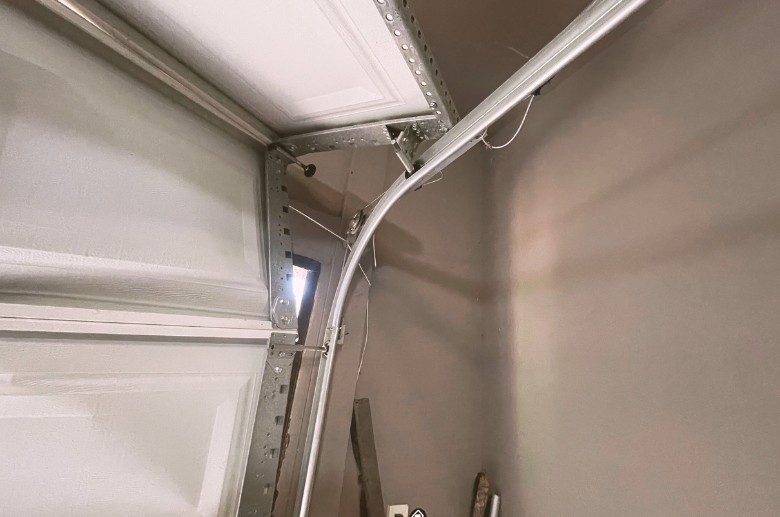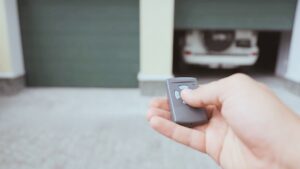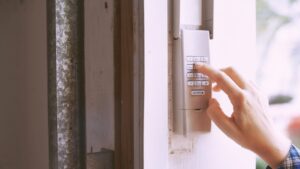Connect With A Garage Expert
Connect with local experts, Compare quotes, Get the best price.
A properly working garage door should open and close smoothly and evenly. However, it can sometimes become unbalanced and shift to one side when opening. Some common causes of an unbalanced garage door include misaligned tracks, worn-out springs, or cables that have come off the pulley.

In this article, we’ll discuss why your garage door shifted to one side when opening, suggest some quick fixes to realign the door, and recommend ways to prevent garage door balance issues in the future.
Why Your Garage Door Shifted to One Side When Opening
An uneven garage door can be an annoyance and can even make it difficult or impossible to use the door. Here’s why you might have this problem.
1. Uneven Tension in The Torsion Springs

Garage door torsion springs provide the counterbalance that allows the door to open and close smoothly and help lift it. If the tension is uneven between the two springs, it can cause the door to shift or bend to one side when opening.
Signs that the garage door springs have uneven tension
- Sideways Drift or Drag: A clear sign of uneven tension is when the door leans or drags to one side while opening. This occurs because gravity pulls more heavily on the side with less spring tension, causing uneven lifting.
- Track Misalignment: The horizontal tracks should be perfectly aligned; any tilt or discrepancy in height suggests uneven spring tension, which can lead to track misalignment over time.
- Uneven Closure: If the garage door does not rest flat on the ground when closed, it’s likely that one side is being pulled down more than the other due to uneven spring tension.
Causes of uneven spring tension
- Wear and Tear: Over time, springs can lose tension unevenly due to natural degradation, leading to one spring weakening faster than its counterpart. Regular maintenance can mitigate severe imbalances.
- Cable and Pulley Issues: A frayed or broken cable on one side reduces tension, while loose pulleys can cause uneven resistance, making one spring work harder than the other.
- Differential Stretching: Springs may stretch and lose tension at different rates, even if they’re of the same age and quality, necessitating periodic replacement or adjustment for balance.
Quick Fixes
Attempting to adjust or inspect torsion springs without the necessary expertise is extremely risky due to the high tension these springs are under. Such adjustments demand specialized training and the use of professional tools to avoid serious injury.
However, you can do a quick visual check for uneven tension. Look for signs like the door dragging, tilted tracks, or uneven closure, as covered earlier. You may be able to diagnose the issue, but garage repair should be left to a pro.
2. Worn or Broken Cables
The cables on garage doors act as a reinforcement to help lift the door. They connect the bottom of the door to the counterbalance spring system.
How to Identify and Causes
To spot potential problems with your garage door cables, closely examine them for wear and tear. Signs such as fraying, kinking, or the presence of broken strands and gaps in the cable weave indicate that it is damaged.
Additionally, look out for corrosion, which can weaken cables over time due to moisture exposure. Visible damage to the cables is a clear indicator that a replacement is needed shortly.
Ignoring cable maintenance can have serious repercussions. Worn cables may snap unexpectedly, potentially causing the door to malfunction, go off track, or drop suddenly. Furthermore, damaged cables can overburden other garage door components, exacerbating the overall wear.
Quick Fixes
Attempting DIY cable repairs risks injury and faulty installation. However, you can visually inspect yourself for fraying, kinking, or broken strands. it’s best to consult a technician for a thorough evaluation. For any major cable issues, enlisting a professional with the right tools and expertise is crucial for safe and effective replacement..
Preventative Measures for Cable and Track Maintenance
Reducing friction through regular lubrication of pulleys and bearings can help prevent cable wear. Additionally, operating the garage door smoothly without jerky movements can decrease strain on the cables. Implementing periodic inspections and proactively replacing cables before they break can ensure a seamless operation over time.
3. Broken Rollers or Bearings
Broken or worn rollers and bearings can cause a garage door to stick, bind, or open unevenly. The rollers slide the door along the track and allow parts to move smoothly.
How to Identify and Causes
To pinpoint issues with rollers and bearings, pay attention to any unusual noises or resistance during operation. Rollers that emit loud noises, seize up, or fail to spin freely are clear indicators of wear or damage. Visually inspect the roller brackets for cracks or absences. Such damage can disrupt the door’s alignment and balance, resulting in uneven movement and additional stress on the system.
Quick Fixes
Applying silicone-based lubricants to the rollers and hinges can significantly improve operation smoothness. While lubrication is vital for minimizing friction, it’s also essential to address and resolve any signs of wear or damage promptly.
Signs like grinding noises or erratic movements suggest underlying issues, necessitating the replacement of any broken rollers or brackets.
Connect With A Garage Expert
Connect with local experts, Compare quotes, Get the best price.
How To Prevent Issues With Broken Rollers Or Bearings
Periodic inspection by a technician can identify wear early. Catching problems before parts break prevents misalignment and damage to the door. Rollers and bearings do undergo normal wear, though, so timely replacement is needed. Letting a garage door company handle this maintenance will prevent future operational issues.
4. Misaligned Tracks

Misaligned tracks can significantly influence your garage door’s operation, causing it to dent, stick, jam, or unevenly open. Since tracks are essential for guiding the rollers, maintaining their proper alignment is fundamental.
Misalignment can result from various factors, including normal wear that gradually bends the tracks or more immediate impacts, such as damage or a broken spring that displaces them.
Signs of misalignment include a door that frequently goes off track or struggles to open, which suggests an issue. A visual inspection can confirm whether the tracks are straight and parallel.
Forcing a door with misaligned tracks can strain and potentially break other components, necessitating extensive repairs.
Quick Fixes
For minor bends, it’s possible to carefully loosen and adjust the tracks yourself, provided the hardware remains intact. However, significant adjustments or replacements should be entrusted to professionals to ensure precise alignment and avoid future complications.
How To Prevent Issues With The Track
Regular maintenance is key to sustaining proper track alignment. Lubricating the rollers and hinges can prevent the hardware from seizing and inadvertently shifting the tracks. Periodic inspections by a technician can detect early misalignments, allowing for timely corrections.
While some impacts may be unavoidable, consistent professional servicing can significantly extend the lifespan of your garage door tracks, ensuring smooth and reliable operation.
5. Issues With The Extension Pulleys

Issues with the extension pulleys can significantly impact the performance of a garage door. If these pulleys malfunction or become misaligned, they can cause the door to operate unevenly or fail to open and close properly.
How to Identify and Causes
Identifying issues with extension pulleys involves a few key steps. Visually inspect the pulleys for any signs of wear, misalignment, or damage. Listen for unusual noises during door operation, as squeaking or grinding sounds may indicate problems with the pulleys.
Continuous use, exposure to weather, and lack of maintenance are the most common causes that can lead to the deterioration of pulley components, impacting their proper function. Regular visual inspections and prompt replacement of worn or damaged pulleys ensure smooth garage door operation.
Quick Fixes
Start with a visual inspection for a quick DIY check and fix of extension pulley issues. Ensure the pulleys are correctly aligned, not damaged, and exhibit no signs of wear. Lubricate them to enhance smooth movement. If the pulleys are misaligned or worn, carefully realign or replace them.
How To Prevent Issues With The Extension Pulleys
Keep the pulleys well-lubricated to minimize friction. Ensure that the garage door tracks are clean and free from debris. While homeowners can perform essential maintenance, seeking professional assistance for a comprehensive inspection and tune-up is highly advisable.
Final Thoughts
In summary, addressing a garage door shifted to one side requires timely attention to prevent further damage. Regular checks on tracks, rollers, and balance are essential. Embrace proactive maintenance to ensure a safe and smooth operation. Remember, if tackling these issues feels beyond your comfort zone, consult a professional.
Ready to restore balance to your garage door? Get a free consultation now!




